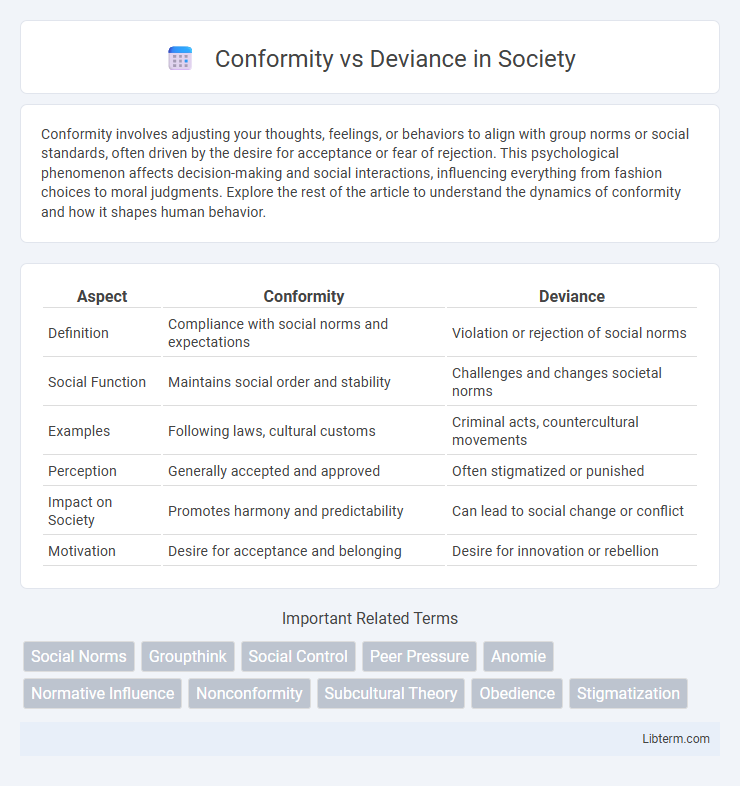Conformity involves adjusting your thoughts, feelings, or behaviors to align with group norms or social standards, often driven by the desire for acceptance or fear of rejection. This psychological phenomenon affects decision-making and social interactions, influencing everything from fashion choices to moral judgments. Explore the rest of the article to understand the dynamics of conformity and how it shapes human behavior.
Table of Comparison
| Aspect | Conformity | Deviance |
|---|---|---|
| Definition | Compliance with social norms and expectations | Violation or rejection of social norms |
| Social Function | Maintains social order and stability | Challenges and changes societal norms |
| Examples | Following laws, cultural customs | Criminal acts, countercultural movements |
| Perception | Generally accepted and approved | Often stigmatized or punished |
| Impact on Society | Promotes harmony and predictability | Can lead to social change or conflict |
| Motivation | Desire for acceptance and belonging | Desire for innovation or rebellion |
Understanding Conformity: Definition and Types
Conformity refers to the process through which individuals adjust their behaviors, attitudes, or beliefs to align with group norms or social standards. It can be categorized into three main types: compliance, where behavior changes publicly but not privately; identification, involving adopting behaviors to establish or maintain relationships; and internalization, where individuals fully accept the group's norms both publicly and privately. Understanding these types helps explain the varying degrees to which social influence shapes personal and collective behavior.
Exploring Deviance: Meaning and Forms
Deviance refers to behaviors, beliefs, or characteristics that violate social norms or expectations, challenging societal standards. It manifests in various forms, including criminal acts, subcultures, and nonconformist lifestyles, each reflecting different degrees of norm violation. Sociological theories such as strain theory, labeling theory, and differential association explore the causes and social responses to deviance within communities.
Factors Influencing Conformity
Social norms, group size, unanimity, and cultural background significantly influence conformity levels in individuals. Perceived authority and the desire for acceptance within a group increase the likelihood of conforming behavior. Situational factors, such as ambiguity and task difficulty, also play crucial roles in determining conformity.
Motivations Behind Deviant Behavior
Motivations behind deviant behavior often stem from a complex interplay of social, psychological, and economic factors including the desire for social acceptance, rebellion against societal norms, or pursuit of personal gain. Individuals may deviate from conformity due to strain theory pressures where they lack legitimate means to achieve culturally valued goals, leading to innovation through deviance. Understanding these motivations helps in analyzing patterns of rule-breaking and the social functions deviance serves in defining and reinforcing community boundaries.
Social Norms and Their Impact
Social norms function as unwritten rules guiding acceptable behavior within groups, promoting conformity by encouraging individuals to align with collective expectations. Deviance arises when behavior violates these norms, often resulting in social sanctions or stigmatization that reinforce group cohesion. The dynamic interaction between conformity and deviance shapes cultural values and influences social order by defining boundaries of acceptable conduct.
The Role of Group Dynamics
Group dynamics significantly influence conformity and deviance by shaping individual behavior through peer pressure, social norms, and collective identity. Strong group cohesion increases conformity as members align their actions with shared expectations to maintain acceptance and avoid sanctions. Conversely, groups that tolerate or celebrate innovation and dissent can foster deviance, encouraging members to challenge norms and introduce new ideas.
Consequences of Conformity in Society
Conformity in society fosters social order by promoting predictable behaviors and reinforcing shared norms, which facilitates cooperation and stability. However, excessive conformity can suppress individual creativity and critical thinking, potentially leading to social stagnation and resistance to necessary change. The consequences of conformity also include the risk of perpetuating injustices when dominant norms discourage dissent or challenge to unethical practices.
The Effects of Deviance on Social Order
Deviance disrupts social order by challenging established norms and provoking responses that reinforce collective values. It can lead to social change by highlighting deficiencies in current norms and encouraging adaptation or reform. Persistent deviance often necessitates legal and institutional interventions to restore stability and maintain societal cohesion.
Balancing Conformity and Individuality
Balancing conformity and individuality requires navigating social norms while preserving personal authenticity and unique perspectives. Emphasizing adaptive conformity allows individuals to integrate into communities without suppressing creativity or critical thinking. This equilibrium fosters social cohesion alongside innovation and self-expression, essential for healthy group dynamics and personal fulfillment.
Real-World Examples: Conformity vs Deviance
Conformity is evident in workplace dress codes where employees adhere to company standards, promoting unity and professionalism. Deviance appears in whistleblowing incidents, where individuals challenge unethical corporate practices despite potential repercussions. Social norms shape behavior, yet deviance can drive social change by highlighting and addressing systemic issues.
Conformity Infographic

 libterm.com
libterm.com